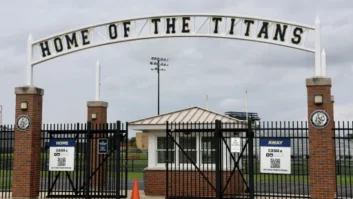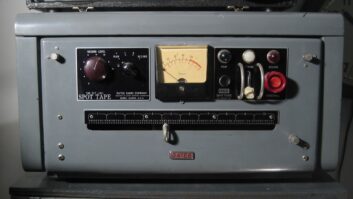
Tune into Delaware’s Travelers’ Information Stations and eventually you will hear a recorded station identification: “This is WTMC-1380 AM, broadcasting from Delaware’s 24-hour Transportation Management Center, providing the latest statewide traffic and transit information. This broadcast is also streamed on the internet at www.deldot.gov and the DelDOT app.”
Delaware’s Department of Transportation has its own licensed Class B AM radio station, linked to 21 synchronized low-power TIS/HAR AM transmitters and antennas located across the state, with three more under construction; and it has just added an FM signal too.
WTMC — the call sign is for “Transportation Management Center” — covers over 90% of Delaware with constantly updated traffic, weather, and public safety information. It is licensed to Wilmington in the north end of the First State.
“We have anchored DelDOT’s traffic information on WTMC because radio is the medium that keeps working when storms have knocked out cell service and the internet,” said Gene Donaldson, DelDOT’s TMC operations manager and the person in charge of the state’s TIS service. “Everybody has an AM radio somewhere.”
FROM TOP 40 TO TRAFFIC
Wilmington’s WTMC is the descendant of WAMS, which went on the air in 1948 and was owned by the Wilmington Tri-State Broadcasting Company (later Rollins Broadcasting of Delaware), founded by John W. Rollins and his brother O. Wayne Rollins. According to FAA records, WAMS had a directional antenna system and daytime broadcast power of 1,000 watts courtesy of an RCA BTA-1L transmitter.
Like many AM stations, WAMS went through many formats in its lifetime. By the time it signed off in 1986, WAMS was a top 40 music station (its call sign has been used elsewhere since). DelDOT acquired the AM license in 2000, reviving the station as WTMC-1380 with 24/7 recorded traffic and weather information.
Today, WTMC-1380 broadcasts at 250 watts during the day and 10 watts at night. “When we drop to 10 watts at night, we fill any gaps using TIS/HAR stations,” said Donaldson.
WTMC is located at Delaware’s Transportation Management Center southwest of Wilmington between highways I-95 and 295. This is where DelDOT staff record audio information into the station’s playout server, using a microphone-equipped, soundproof cubicle in the TMC office complex. WTMC’s nondirectional AM tower and transmitters are also located within the I-95 right of way at the I-295 merge south of Wilmington. (The old WAMS five-tower array was a few miles to the north and taken down for development in the 1980s.)
[TIS Is a Stalwart of Our Radio Landscape]
With the help of Information Station Specialists of Zeeland, Mich., which focuses on installing and servicing TIS/HAR stations, DelDOT erected low-power TIS/HAR stations to turn WTMC into a true statewide broadcaster, using TIS/HAR stations to serve south of Wilmington beyond WTMC’s coverage contour.
“Delaware is the only jurisdiction where a DOT has purchased a commercial radio station license and then augmented it with multiple synchronous TIS/HAR stations to effectively cover a state,” said Bill Baker, owner of Information Station Specialists.
“It is also the largest operator of multiple synchronous TIS/HAR stations in America,” he said, and the department is about to add more.
NOT JUST RADIO
WTMC’s pre-recorded reports can be heard online and via the DelDOT app (Apple and Android) because DelDOT wants to deliver traffic/transit, weather and emergency information via audio to listeners by all means possible.

“This is why our electronic highway signs are equipped with flashing beacons,” said Donaldson. “When these beacons start flashing, drivers know it’s time to tune into 1380 AM to get the latest breaking traffic/weather news — or to have someone call it up on the DelDOT smartphone app in the car.”
And like many other, more traditional AM broadcasters, DelDOT has taken advantage of the recent FCC rule change and has added an FM translator, on 98.5 MHz.
Lee Afflerbach, co-owner of CTC Media Group, a professional engineering firm that has helped DelDOT build its TIS/HAR network, said, “It will target the highly travelled I-95, I-495 and I-295 corridor. The translator will include RDS digital service of DelDOT’s web-based information resources. Also in the picture is an AM power increase with an added digital transmission component.”
Analog AM radio remains at the heart of DelDOT’s overall information delivery system. “When things start to fail in bad weather, you can count on AM radio to get through,” Donaldson said. “This is why DelDOT still counts on AM radio today.”
WAMS TRIVIA
The manual for WAMS’ original RCA BTA-1L 1,000-watt transmitter can be found online at https://tinyurl.com/rw-wams-rca.
“This transmitter will provide reliable, high-fidelity operation at any frequency between 540 and 1600 kc with negligible distortion and low carrier noise,” said the BTA-1L manual. “It is very easily installed, requiring only the connection of external wiring and the bolting of cabinets together.”
The original FCC card files for WAMS have been digitized, and can be read online at https://tinyurl.com/rw-wams-cards. Captured on old microfiche film, the cards have since been destroyed to save storage space. These cards run from WAMS’ initial license approval in 1948 to its last license renewal in 1981.
A classic aircheck from the summer of 1976 can be heard on YouTube; search the site for “Bobby Dark 1976.”







